Soyez prêt ! (Alpha)
| |
|---|---|

|
Le système de combat de Camelot Unchained autorise les joueurs à construire un vaste panel de compétences à l'aide de composants, utilisant le Système création de compétences. Avec l'ensemble de physics, collision detection et de A.I.R. System, cela devrait rendre les combats plus complexe tactiquement.
Le skill progression / leveling up des joueurs évoluera en conséquence avec les combats contre les enemies des autres Royaumes - Vous progresserez grâce au PvP, et non pas avec les quêtes ou en tuant des monstres. Les personnages qui mourront au cours d'une bataille ne pourront revenir facilement sur le lieu du combat [1],[2], les structures ennemies pourront être ramassées/pillées [3],[4] et détruite néanmoins il n'y aura pas de loots sur les corps des joueurs.[5]
Aperçu[ | ]
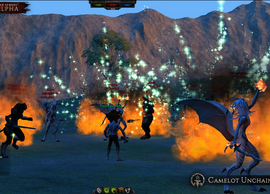
Skirmish (early alpha)
- Le Combat sera basé sur la mécanique de 'Pierre, papier, ciseau' et l'inter-dépendance des Classes à travers la "Sainte Trinité" dans les combats entre personnages ainsi que de puissants archetypes.[6]
- Il n'y aura pas de GCD (global cooldown timer ou temps de récupération globale des compétences).[7]
- Les joueurs auront accès un un grand nombre de compétences à un moment donné, le challenge sera de choisir lesquels utilisés [8], because as the Foundational Principle #4 says - Le choix comptes!
- Le ciblage sera un hybride , contenant en partie un ciblage avec TAB couplé avec des méthodes de visées alternatives.[7]
- Il y aura du contrôle de foule [9],[10] (probablement pour soutenir les petites équipes mais bien organisées) et collision detection [10],[11].
- Les joueurs créent tous leurs propres compétences: sauf les principaux composants, aucune compétence est préfabriquée, tout le monde peut créer des compétences pour être en adéquation avec leur style de jeu préféré, et pas jouer seulement les classes qui sont créés pour eux.
- Quatre catégories différentes de composants, beaucoup d'entre-eux possèdent leur propre personnalisation donnant un grand nombre de combinaisons possibles.
- Le Système supporte les interruptions, les coups positionnels, les coups réactifs, et d'autres éléments de base du système de combat.
- L'armure protège seulement"" la partie du corps qu'elle recouvre, et les dégâts sont gérés individuellement selon les partie du corps - Chaque partie à ses propres points de vie et d'effets de blessures. Par exemple : une épaule blessée influence la vitesse de frappe à l'épée, et non pas la vitesse de déplacement (au contraire d'une blessure à la jambe)
- Quote: "le Combat, inclue le combat magique, Cela pourrait être innovant et amusant. Le monde a assez de MMORPG avec des systèmes de combats qui sont similaires à la plus part des autres MMORPG." [12]
- Le système de combat est spécifiquement orienté vers les joueurs expérimentés (ou des joueurs qui recherchent un meilleur challenge) à l'esprit [12]; les petits levels auront accès à une zone de départ sorte de didacticiel Champ de bataille, afin de les préparer au RvR.
Composant du système de combat[ | ]
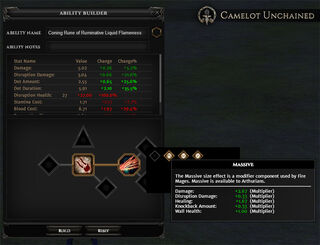
builder en action
- Utilise une variante des Composants du système de magie vue dans d'anciens jeux, particulièrement le MUD Dragon's Gate, également de Mark Jacobs.
- Toutes les capacités sont créent par chaque joueur pour eux même à partir du Système création de compétences.
- Le Combat est partiellement équilibré par la puissance de chaque capacité, qui sont limitées par un taux limite de valeur, qui représente combien une capacité peut être forte après modification par le joueur.
- Avec chaque nouveau composant ajouté à une capacité, le taux de valeur augmente. Il ne peut dépasser le taux de valeur limite fixé à la capacité.
- De nombreux composants ont aussi une variable d'ajustement qui peut être faite, ajustant à nouveau le taux de valeur.
- Les joueurs ont un contrôle précis sur l'estimation des taux de valeurs et tous les ajustements apportés.
Combat-body parts/armor[ | ]
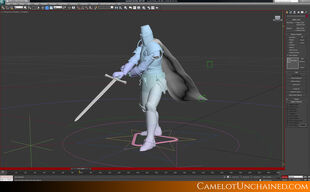
Animating Stormrider`s sword combat
- Each part of a character’s body is protected only by its own piece of armor
- Unlike the way of most games, armor only protects the part of the body that it covers. Your helm doesn’t help you when you are struck on the leg!
- Body parts take damage individually, and each part has its own pool of health and injury effects
- A shoulder wound could reduce how fast a player can swing a sword, but it won’t stop that player from running away
- Player-created abilities can add a modular component to target a specific region of the body
- Paying careful attention can give the attacker an advantage, but if the attacker targets an area that the defender is guarding or quickly moves to protect, the advantage could shift
- Certain components will also allow a defender, after a successful defense, to perform a special counter-attack on the attacker
- Abilities always trigger cooldowns once started, and cost resources whether they complete successfully or not.
- Abilities also have a “Disruption Value” which is damaged by “Disruption Damage” from hostile abilities. If an ability takes too much disruption damage, it is interrupted. Too much disruption damage can result in a very negative effect on the player whose ability was disrupted.
- The more powerful the ability disrupted, the more likely the backlash from the ability will hurt the user of the ability.
Developer Quotes[ | ]
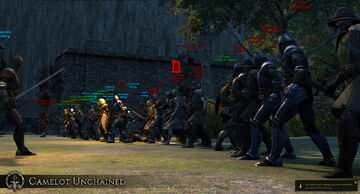
3...2...1... (Alpha tests)
Question: It was previously mentioned that solo play should and will be a viable option in CU. How are you going to make it happen?
Renée Machyousky: Mark is a fan of solo play. So, while we can’t describe actual mechanics/details at present, I feel confident saying solo play will be a viable option for those who prefer that playstyle.[13]
Mark Jacobs: Is small group combat going to be useful in CU? Absolutely! And I also want this game to support solo play.[14]
Mark Jacobs: We are going to do everything from the design perspective to make buffboting almost impossible [14] (here Mark has in mind not banning IPs, but designing the game in such way to discourage buffbots, as explained earlier in the reference).
Renée Machyousky (answering the question about TTK - time to kill): "This is a rather loaded question and a lot factors into this. For instance, clearly some characters will be far more vulnerable (lower HP and resists) than others. I can at least say this, we are not over fond of insta-gibbing. We want battles to be hard fought, with plenty of give and take." [4]
Mark Jacobs (talking about the eventual different ranges of different melee weapons, here - swords versus spears): We'll certainly try that.[14]
Renée Machyousky: Some players may prefer to have two sets in PvP. These players should be prepared to experience a penalty (time/vulnerability) for swapping out weapon or gear sets while on the field of battle.[13]
Mark Jacobs: "I want a combat system that is reactive, flows smoothly, fluid/etc. and one where the player(s) have to think a little for themselves without the game doing so much for them. I also don't want to see CU be a game where combat boils down to "1-2-3" "1-2-3" "1-2-3-4" rinse, wash repeat." [15]
Question: "...How are you going to break up the zergs that make RvR so much fun!"
Mark Jacobs (part of the answer, concerning combat): "...While having lots of extended CC abilities is a tad bit controversial, we will certainly have some CC (as well as resists and ways to clear the CC) so that smaller groups can have a better chance at dealing with larger groups." (...) "When you die, and you will die; don’t expect to simply pop back up and get right back in the fight. It is going to be a lot more complicated than that. IMO, that gameplay style embodies some of the problems with many modern MMOs, death without consequence, “easy in” and “easy out” RvR, 6-year old kids’ soccer match, etc. RvR combat must be fun, challenging, exciting and losing must hurt a bit or it means nothing." [1]
Ben Pielstick: "Our criticals are not a simple damage boost with a relatively high percentage chance, which probably happens several times in each fight. Our criticals are extremely rare, and a critical result isn’t always a good thing, since the table of possible results ranges from awesome successes to spectacular failures. As Mark pointed out in Foundational Principle #8, we want these occurrences to be “water cooler conversation” moments, and that just doesn’t happen for something you see several times a fight, or even several times a day." [16]
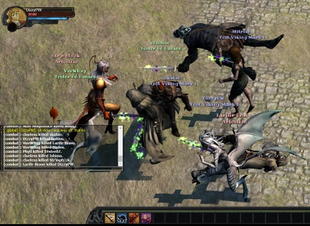
A brawl (pre-Alpha tests)
Mark Jacobs: "I also understand the concern of players who really don’t want too much randomness in their game because that can lead to far too many truly unexpected losses and frustration with the game’s mechanics, including the much maligned random number generator. What I propose is that this game’s combat systems have enough randomness built into them that players will not know that every time they swing their sword, they will always hit for X damage.
I don’t want the player to know that every time they go into a 1:1 battle with someone of equal knowledge/skill but with a slight lower character that the outcome is easily and thoroughly predetermined. However, the system’s damage combat mechanics will be laid out so that the majority of damage will be set but where only a portion of it is random but with a strong critical hit/miss system component as well. We should have a bit more fun with very rare rolls on both sides of the success spectrum. I want to add some special critical hits and critical failures to the game, as I believe that they will add a lot of spice as well as some much needed humor and occasional pathos to the game.
Critical hits & failures will be rare but every so often, something should happen of such monumental glory that the players end up discussing these as “water cooler conversations” the next day. Yes, it will not be fun to be on the receiving end of course but on the other hand, if you are on the other side or simply enjoy a good chuckle, your seeing that powerful Tuatha Dé Danann mage cast a mighty spell and being turned into a horned rabbit might make your day. Again, I don’t want to turn this game into an evening’s worth of blooper reel entertainment but a little randomness could add some truly awesome moments into the game or as my son would say making it “fresh.” " [17]
Vines[ | ]
Videos[ | ]
Combat animation basics[ | ]
Early ability builder in action (skip to 0:45)[ | ]
The Opposition Podcast with Mark Jacobs[ | ]
- Here (the first post in that thread) is the list of topics, in order in which they appear in the video below - skip to 56:02 for crowd control, positionals and death penalties, or skip to 1:13:15 for collision detection, formations, shieldwalls, turtling and so on:
BSC Days combat[ | ]
Combar Q&A[ | ]
part 1:
part 2:
part 3:
List of Kickstarter videos concerning combat[ | ]
Kickstarter update 04-06-2013, with the first half of the video inside (skip to 3:25 for combat): Afternoon Update - Part 1;
Kickstarter update 04-06-2013, with the second half of the video inside: Afternoon Update - Part 2;
Kickstarter update 04-27-2013, with the Mark-A-Thon Part 3 video inside: Afternoon Update - Mark-A-Thon Part 3.
Sources[ | ]
- ↑ 1,0 et 1,1 http://camelotunchained.com/v2/foundational-principle-2-rvr-isnt-the-end-game-its-the-only-game/
- ↑ http://camelotunchained.com/v2/newsletter/unveiled-2/
- ↑ http://forums.mmorpg.com/discussion/comment/6691110/#Comment_6691110
- ↑ 4,0 et 4,1 http://camelotunchained.com/v2/piercing-the-veil-6/
- ↑ https://www.youtube.com/watch?v=MFe3zlpRw4E
- ↑ http://us5.campaign-archive1.com/?u=2b70fd18d895dd960141bac55&id=3a094e3c48
- ↑ 7,0 et 7,1 https://www.kickstarter.com/projects/13861848/camelot-unchained/posts/447536
- ↑ https://www.kickstarter.com/projects/13861848/camelot-unchained/posts/447951
- ↑ https://www.kickstarter.com/projects/13861848/camelot-unchained/posts/450178?ref=activity
- ↑ 10,0 et 10,1 https://www.youtube.com/watch?v=DcoSkLeMdTs
- ↑ http://massivelyop.com/2015/03/04/camelot-unchained-starts-alpha-distributes-standalone-builder/
- ↑ 12,0 et 12,1 Combat Document
- ↑ 13,0 et 13,1 http://camelotunchained.com/v2/piercing-the-veil-7/
- ↑ 14,0 14,1 et 14,2 https://www.kickstarter.com/projects/13861848/camelot-unchained/posts/465723
- ↑ https://www.kickstarter.com/projects/13861848/camelot-unchained/comments?cursor=2614238#comment-2614237
- ↑ http://us5.campaign-archive1.com/?u=2b70fd18d895dd960141bac55&id=9e9991d1d5
- ↑ http://camelotunchained.com/v2/foundational-principle-8/
